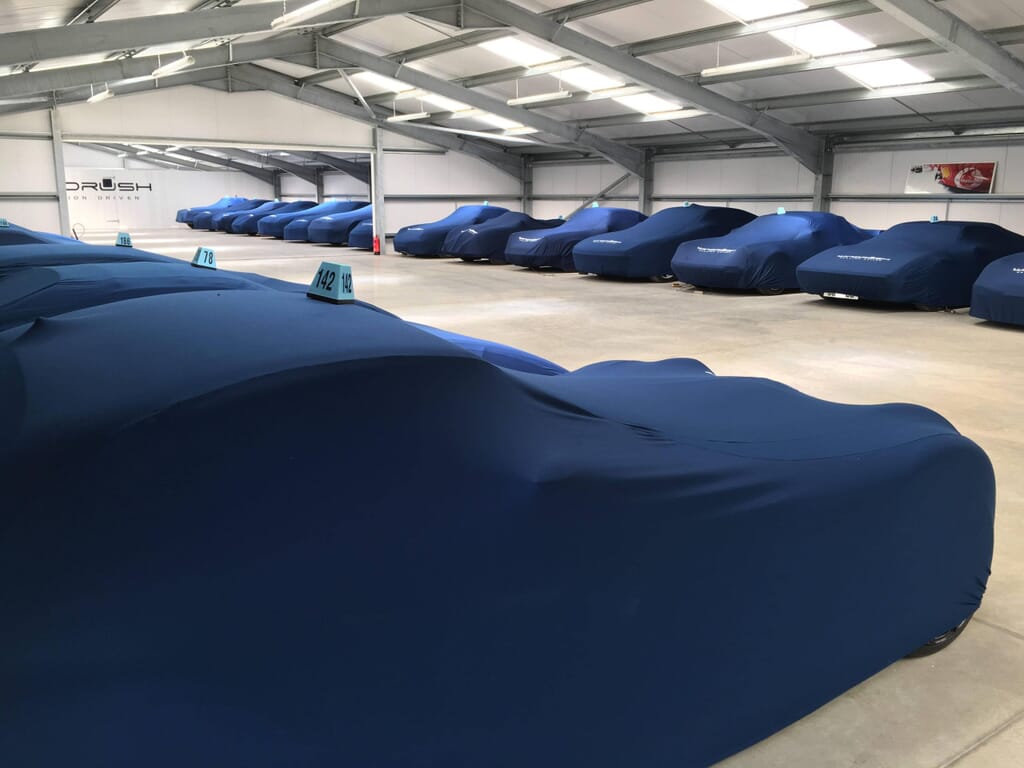
Whilst everyone will most likely be keen to keep their pride and joy in pristine shape, not everyone has access to a custom made indoor car storage solution. Some of us have plenty of external space but little indoor space, or for those of us with indoor space it can often be affected by several factors from humidity to light. With that being said, what options are there for outdoor vs indoor car storage, and which is ultimately superior?
Outdoor Car Storage
Let’s begin at the most common starting point – outdoor car covers. Characterised by harder wearing, thicker materials and anchoring points to keep your car under cover in all weathers, these are available at a variety of price points and as with most products in the car world you do get what you pay for.
The most important feature of all in an outdoor car cover is its physical composition, a point far more important than aesthetics. Multilayer fabrics are crucial as they allow air to circulate and prevent trapped air and moisture beneath the cover. Although it may sound slightly counter intuitive at first, a 100% water resistant cover will not allow any circulation. Look for a well fitting, highly UV and water resistant outdoor cover with multilayer fabrics and properly considered straps to prevent material movement and scratching of your paintwork beneath.
For those with a bit more space, or seeking a more permanent solution, outdoor tents or gazebos often referred to as ‘carports’ are now very commonly available even at high street DIY stores. These semi-permanent structures use metal frames and a choice of various roof materials from plastic to metal and even wood, either mounted off the ground of using a wall for support. The main advantage of these is ease of use – simply drive in and drive out and your car is under cover without any hassle or removal of covers and such like. Realistically these do not offer a whole lot of real world protection, often with exposed side sections which do not entirely protect your vehicle from the elements, and are therefore aimed more at daily drivers than cherished classics.
But for such cherished classics there is the option of the outdoor Carcoon, or ‘bubble’, which are variants of the popular indoor AirChambers used by Windrush. The pros to this are clean, filtered air surrounding your car, with nothing touching the paintwork, as well as superior protection from UV and moisture deterioration. These are however a more expensive option, and also rely on a nearby power source to run them as well as suitable outdoor space for them.
Indoor Car Storage
For indoor car storage, a standard Air Chambers is easy to erect, economical to run (typically around 20 pounds per year) and simple to use. Twin fans force up to 50,000 litres of clean, filtered air across every surface of your vehicle evaporating moisture and banishing condensation. Free standing with an internal supporting frame allows you to easily access your pride and joy by opening zipped access panels at the front or side of the AirChamber.
Absolutely nothing touching your cars paintwork, which is a big advantage, but be conscious of the space required as well as access to power.
If you have slightly less space available, or are looking for a more cost effective solution, investing in a quality indoor car cover will go a long way. As we’ve covered in our section on choosing the right car cover, the key attributes to look for are well fitting, breathable, non-hydroscopic, dust proof and non-scratch materials. For most applications, a good quality cover in an indoor space is a perfect solution for most, provided that indoor environment is correct.
As to what creates the target environment for car storage, this comes down to a combination of heating, ventilation and dehumidification.
In summary, there are a number of solutions for both outdoor and indoor car storage to suit your requirements. It’s no secret that an indoor setting with the target environment is the preference when storing your vehicle, but if you are going down the outdoor route there are solutions available.




